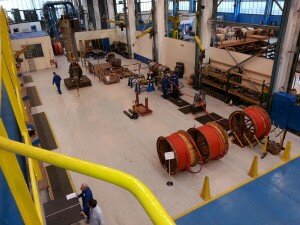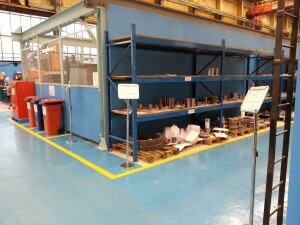“Over the years we have had many attempts from different management teams coming in and trying to take the business forward and drive it into the future. They all had their successes to varying degrees but ultimately the sites were continuing to degenerate.”
Despite these endeavours, the organisation was facing significantly overdue supplier payments, warranty claims in excess of £1 million, late deliveries, a negative work culture and an unsupportive bank. Delving deeper into the politics of the company, the turnaround team discovered that there was “little accountability, they were over manned and unsupported”. With 20 years of lean experience at Motorola and determined to improve Hayward Tyler, Martin Clocherty assembled an improvement team of 10 to revitalise the business. Martin was adamant that he didn’t want an external consulting agency coming into the organisation and telling them what to do.
“We took responsibility, we forgot about the history, about blame, and about what had happened in the past. We all decided that we were going to do something about it. Everyone: IT teams; purchasing teams; manufacturing teams; we brought everyone together and we put a one year plan together and said we are not going to wait for anyone else to come and help us. We are going to step up to the plate and take this on.”
The team devised and implemented a one-year plan containing two strands running in parallel, the first was to drive change through new and improved working practices and the second was to address the structure of the business.
“We were standardising the system, purifying the source data, using the ICT systems to give us information on how to run a business better and at the same time physically improving the site. The reason for doing this as well, is so that everyone in the business is touched with change. Every office changed, every part of the shop floor changed, everyone was involved.
We then looked at the root cause, which was the accuracy of our source data. Over the years the management over data had been neglected, all our decisions were based on the poorly managed source data, resulting in poor decisions. Planning, scheduling and customer decisions were all floored.”
During the turnaround process Hayward Tyler ran somewhere the region of 50 5s and 20 kaizen events, all of which included representation from every department. The turnaround team realised there was no targeting system, which meant there was no way of measuring the performance of the factories.

“We created a system called ‘burn hours’, which were our productivity hours. We called it this because when we take a contract on, for example, a BCP, to complete the manufacture of a BP it takes about 1000 man hours, the way to measure it in simple terms, is to track it over 10 weeks and 1000 hours should go down by 100 hours every week.
“We looked at the load at the start and we measured it burning down, so if we only burned 50 hours in one week, we could see that we were behind. We could now ask ourselves questions, are we burning enough hours every week? Where are we burning the hours? This allowed us to learn and measure the skills matrix, constraints and bottlenecks.
“Through this we discovered the leadership team wasn’t managing due to the chaos, so we implemented direct accountability where everybody is measured.”
Once the organisation had analysed the gathered data, Hayward Tyler created a bespok system and distributed it across the firm. The key to its success was making all the information available to everyone.
“Sales info, order in-take, profit margins, everything is available, this is to make everybody accountable. Negative culture littered accountability, you could go to the shop floor and they would say ‘order intake’s not my problem’, and we would say ‘yes it is’. The way to make them accountable is to have weekly KPI meetings, where we tell them about the weekly intake, and say if you don’t deliver in your area, how can sales win more orders? There is a knock-on effect. We made everyone accountable by making
everything open.”
Clocherty said the next task was to make all the information visual: “We placed a kanban in the middle of the factory. In the past the scrap metal was strewn across the factory and now it is assembled around the kanban, so we could all see it piling up and know when to do something about it.”
The visual cue from the metal piles spurred endeavours to recycle where possible, in fact, the firm has generated £180,000 from recycling since the beginning of the programme and has reinvested it back into the business.

“We make it attractive to the employees, all you have to do is participate and you can have access to the scrap fund. We recently discovered that you can make more profit on copper scrap if it’s stripped, so we invested in a copper stripper. We also sell X-rays back because they contain silver. We have taken the time to understand how to continue to
generate funds.”
It also occurred to the team that it needed to keep it simple in order to get everyone on board and change the culture of the company in the long-term.
“We simplified it, we 5sd it. We have done multiple process stream maps. For six or seven different parts of the business, different people get involved in completing the value stream maps. The problems that the business had were too great for one person to resolve, so we took a team approach to everything. No one person is left on their own.
“We discovered that to achieve lasting success, you have to make sure that you take a
complicated business and you make it simple. It’s almost like the army when you march at the pace of the slowest person, your systems have to be based on your lowest ability.”
The one-year plan allowed an organisational restructure, the business was refinanced, which brought it onto a level playing field and made time for headcount reductions, implementation of an outsourcing strategy and a reshuffle of suppliers, of which it had too many. The great thing in this instance is that the success of the plan is abundantly clear by looking at what has happened to the company since 2011.
“Order intake has increased by 50 per cent, across the board, in all sectors. We have seen an 80 per cent increase in profit. 10 months after the initiative’s inception we had hit record highs of £3 million, hitting record after record gets the workforce motivated because we are continually covering new ground.”
However, the plan does not end after one year: “We have a plan that takes us to 2015, lean systems are at the heart of our plan, and we have integrated sales and operational planning.
“There’s a one year and five-year plan, in order to fulfill the five-year plan you have to hit the one-year plan. Short-term goals ensure that everything is progressing as it should.
“So far we have improved the communication between all of our businesses and affiliated businesses all over the world.”

The results from the case study are startling, the company has increased its share price, improved profitability, engaged its workforce, eliminated late days, increased cash generation, and have successfully recovered customers, to name a few. However, the lean journey does not end there, and neither will it after five years, the concept of making everything available and visual means the organisation will persistently identify obstacles and strive to continually overcome them.

